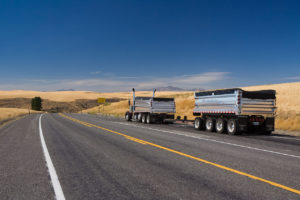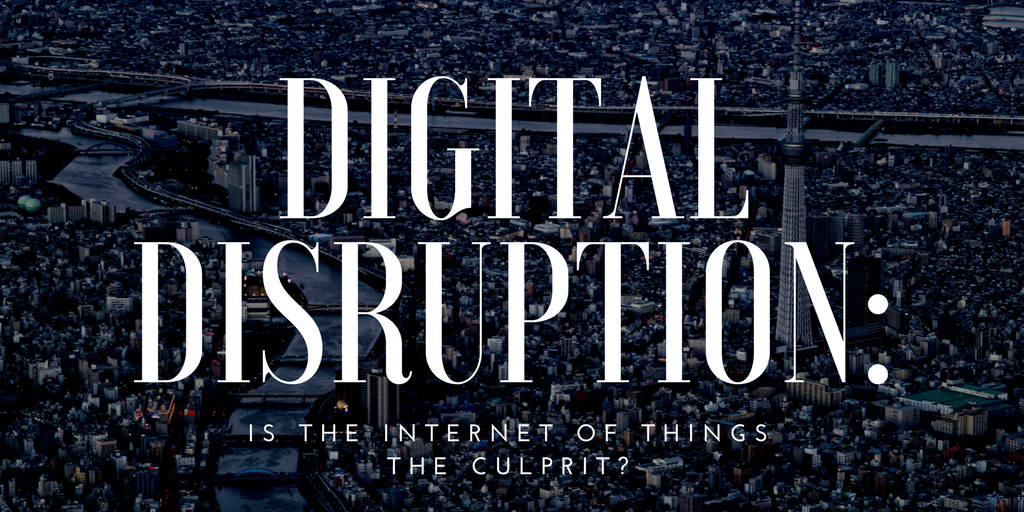The Digital Era is consuming the business world and all industries; this undoubtedly includes the logistics industry. But how? Let’s start with the definition of two concepts: the Internet of Things (IoT) and Digital Disruption. Too man y people have used the Internet of Things as a blanket statement meaning anything digital. IoT is more than that, and most people do not completely grasp the foundation of what the “Internet of Things” really is. Because of the advancement of connectivity to the internet via data streaming from smart devices, using wi-fi signals to connect hardware, we potentially have access to EVERYTHING that is tethered to us electronically at all times. For example, your Bluetooth headphones, your CPAP machine, monitoring your vehicle’s gas consumption, and even your house’s lights are a part of IoT. At the core, it is the relationship between people-people, people-things, and things-things. Gartner, the technology research firm, estimates that there will be over 26 billion devices connected by the year 2020. And what that ultimately means for industries such as Logistics, is anything that can be connected will be linked. Digital Disruption describes the forced evolution of companies and their business models because there are new technologies constantly being offered and implemented to streamline processes. The reason we consider it disruption, is companies need to adopt or often will be left behind. Those enterprises that try to resist technology have a higher chance of becoming obsolete.
y people have used the Internet of Things as a blanket statement meaning anything digital. IoT is more than that, and most people do not completely grasp the foundation of what the “Internet of Things” really is. Because of the advancement of connectivity to the internet via data streaming from smart devices, using wi-fi signals to connect hardware, we potentially have access to EVERYTHING that is tethered to us electronically at all times. For example, your Bluetooth headphones, your CPAP machine, monitoring your vehicle’s gas consumption, and even your house’s lights are a part of IoT. At the core, it is the relationship between people-people, people-things, and things-things. Gartner, the technology research firm, estimates that there will be over 26 billion devices connected by the year 2020. And what that ultimately means for industries such as Logistics, is anything that can be connected will be linked. Digital Disruption describes the forced evolution of companies and their business models because there are new technologies constantly being offered and implemented to streamline processes. The reason we consider it disruption, is companies need to adopt or often will be left behind. Those enterprises that try to resist technology have a higher chance of becoming obsolete.
 y people have used the Internet of Things as a blanket statement meaning anything digital. IoT is more than that, and most people do not completely grasp the foundation of what the “Internet of Things” really is. Because of the advancement of connectivity to the internet via data streaming from smart devices, using wi-fi signals to connect hardware, we potentially have access to EVERYTHING that is tethered to us electronically at all times. For example, your Bluetooth headphones, your CPAP machine, monitoring your vehicle’s gas consumption, and even your house’s lights are a part of IoT. At the core, it is the relationship between people-people, people-things, and things-things. Gartner, the technology research firm, estimates that there will be over 26 billion devices connected by the year 2020. And what that ultimately means for industries such as Logistics, is anything that can be connected will be linked. Digital Disruption describes the forced evolution of companies and their business models because there are new technologies constantly being offered and implemented to streamline processes. The reason we consider it disruption, is companies need to adopt or often will be left behind. Those enterprises that try to resist technology have a higher chance of becoming obsolete.
y people have used the Internet of Things as a blanket statement meaning anything digital. IoT is more than that, and most people do not completely grasp the foundation of what the “Internet of Things” really is. Because of the advancement of connectivity to the internet via data streaming from smart devices, using wi-fi signals to connect hardware, we potentially have access to EVERYTHING that is tethered to us electronically at all times. For example, your Bluetooth headphones, your CPAP machine, monitoring your vehicle’s gas consumption, and even your house’s lights are a part of IoT. At the core, it is the relationship between people-people, people-things, and things-things. Gartner, the technology research firm, estimates that there will be over 26 billion devices connected by the year 2020. And what that ultimately means for industries such as Logistics, is anything that can be connected will be linked. Digital Disruption describes the forced evolution of companies and their business models because there are new technologies constantly being offered and implemented to streamline processes. The reason we consider it disruption, is companies need to adopt or often will be left behind. Those enterprises that try to resist technology have a higher chance of becoming obsolete.Now that we have defined these two concepts let’s focus on why it is relevant to the Logistics Industry. Shippers are constantly looking for less expensive options for shipping their products across the United  States. The shipping clients pass these pressures to the 3PLs, the carriers, and finally the drivers. Companies are now taking advantage of the IoT to track the shipment routes via real-time GPS. This tells the carriers the efficiency of the route, whether the truck driver is taking brakes and for how long, and tracking of fuel consumption. Food shipments can be tracked, monitors, and analyzed like never before, because of the IoT. The biggest Digital Disruption is the implementation of the real-time temperature tracking sensors. This ensures that the food will maintain a particular temperature as it is transported to the grocery store shelf, where the consumer will expect that the food is properly handled from farm to receiver to loader to the carrier and finally to the retail food store.
States. The shipping clients pass these pressures to the 3PLs, the carriers, and finally the drivers. Companies are now taking advantage of the IoT to track the shipment routes via real-time GPS. This tells the carriers the efficiency of the route, whether the truck driver is taking brakes and for how long, and tracking of fuel consumption. Food shipments can be tracked, monitors, and analyzed like never before, because of the IoT. The biggest Digital Disruption is the implementation of the real-time temperature tracking sensors. This ensures that the food will maintain a particular temperature as it is transported to the grocery store shelf, where the consumer will expect that the food is properly handled from farm to receiver to loader to the carrier and finally to the retail food store.
 States. The shipping clients pass these pressures to the 3PLs, the carriers, and finally the drivers. Companies are now taking advantage of the IoT to track the shipment routes via real-time GPS. This tells the carriers the efficiency of the route, whether the truck driver is taking brakes and for how long, and tracking of fuel consumption. Food shipments can be tracked, monitors, and analyzed like never before, because of the IoT. The biggest Digital Disruption is the implementation of the real-time temperature tracking sensors. This ensures that the food will maintain a particular temperature as it is transported to the grocery store shelf, where the consumer will expect that the food is properly handled from farm to receiver to loader to the carrier and finally to the retail food store.
States. The shipping clients pass these pressures to the 3PLs, the carriers, and finally the drivers. Companies are now taking advantage of the IoT to track the shipment routes via real-time GPS. This tells the carriers the efficiency of the route, whether the truck driver is taking brakes and for how long, and tracking of fuel consumption. Food shipments can be tracked, monitors, and analyzed like never before, because of the IoT. The biggest Digital Disruption is the implementation of the real-time temperature tracking sensors. This ensures that the food will maintain a particular temperature as it is transported to the grocery store shelf, where the consumer will expect that the food is properly handled from farm to receiver to loader to the carrier and finally to the retail food store.The Federal Government is even beginning to rely on IoTs to ensure the health of truck drivers which ultimately leads to safer roads. The government has mandated that truckers now take breaks and sleep shifts after specific amounts of time driving. Carriers can ensure these breaks occur because of the digital time stamps and digital logging devices incorporating live GPS coordinates. Many drivers are not fans of this logging, but the at the core it is about the prevalence of driver fatigue. If carriers do not abide by these new regulations, there are severe penalties incurred.
At East Coast Transport, we fully embrace the trend of IoT. For example, we use the best touchpoint software, to keep track of all shipments from loading docks all the way to the final destination. As a third-party logistics company, we are experts in managing links in the supply chain. It is our core competency and responsibility. We have the resources to adjust to changing, individual circumstances, and have the ability to continuously monitor each link in the supply chain to ensure they get the fastest, most efficient service, which in turn means the same for our clients and companies.

